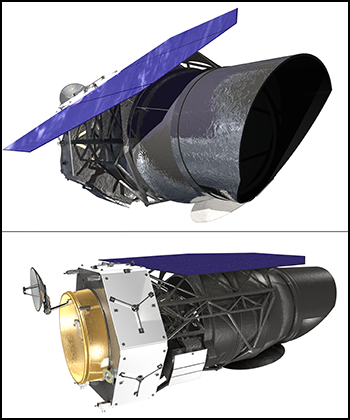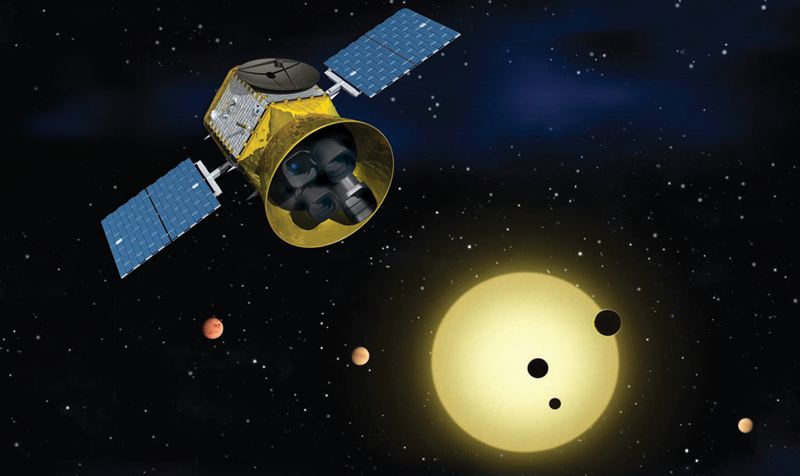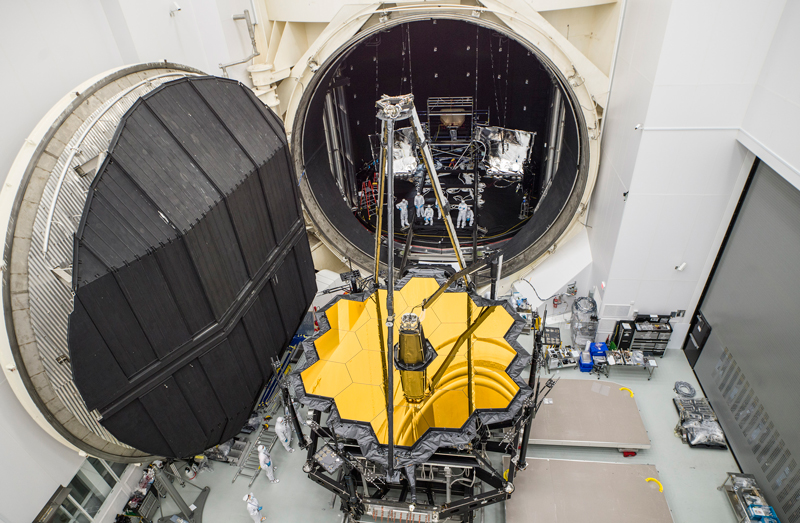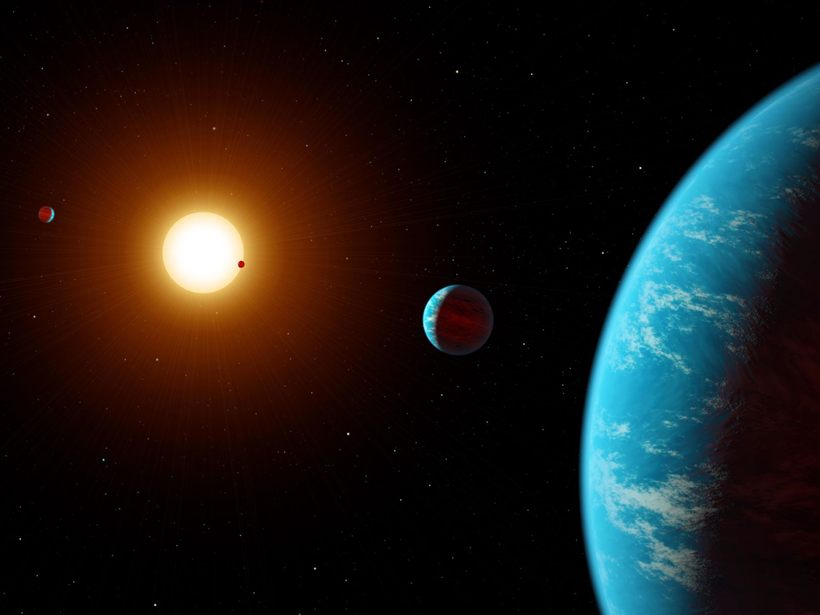Scientists around the globe are currently planning or constructing more than a dozen new missions dedicated to finding and understanding worlds beyond our solar system. The new probes range from sedan-sized siblings of the Hubble Space Telescope (HST) to space observatories with tennis court–sized footprints. Researchers working on many of these new probes gathered with thousands of other astronomers near Washington, D. C., early this month for the 231st meeting of the American Astronomical Society (AAS 231).
Which of these many missions are exoplanet experts looking forward to the most, and why? We at Eos wanted to know. So during AAS 231, we conducted an informal poll via Twitter. Here’s how our 33 respondents voted:
Hey Exoplaneteers at #AAS231! There are so many talks/posters this year about future exoplanet missions. But which one are you most looking forward to? Vote now & comment why your favorite is the best!
Favorite mission not here? Leave a reply and let me know what I’m missing!
— Kimberly Cartier (@AstroKimCartier) January 8, 2018
Just what are these missions? We’ve summed them up, in order of increasing partiality.
Wide Field Infrared Survey Telescope
In last place in our poll is the Wide Field Infrared Survey Telescope (WFIRST). Its expected launch is around 7 years away—a long slog compared to its competitors in this poll. WFIRST is not a dedicated exoplanet telescope. However, as the top space priority of the National Academy of Sciences’ 2010 decadal survey for astronomy and astrophysics, WFIRST deserves some recognition.

WFIRST will be an imaging-only telescope hosting two instruments, a wide-field camera and a coronagraph, both of which will observe in visible and near-infrared light. This telescope will be a cosmology-first mission, expected to observe more than a billion galaxies and study the properties of elusive dark matter and dark energy, but the wide-field camera and superior coronagraph will also provide insight into exoplanets that other current and future space telescopes won’t be able to offer.
The primary mirror is 2.4 meters in diameter—identical to HST—but will have a field of view 100 times wider than Hubble’s. This wide field of view will let it see more objects simultaneously and also zoom in on nearby objects.
The WFIRST team plans to train the wide-field camera on the inner Milky Way. The patch of sky it will survey is estimated to contain approximately 2,600 exoplanets whose gravity causes a miniscule but telltale brightening of a background star, an effect known as microlensing. And WFIRST scientists hope to collect data on them all, potentially increasing the number of known microlensing planets almost 50-fold. The data would fill in gaps in our knowledge of planets that form in the more distant reaches of planetary systems.
Microlensing will find earth sized planets, free floating or attached to stars. Lots of good data, newcomers welcome!#WFIRST #AAS231 pic.twitter.com/SI7E4B0VlK
— Sangeeta Malhotra (@scpticastrodame) January 10, 2018
With the second instrument, the coronagraph, the WFIRST team plans to observe young planets and still-forming planets by blocking out the central star’s light. This process allows the sensitive instrument to directly image the light of the planets themselves. Direct imaging of young planets will increase our understanding of the internal structure, formation, and evolution of exoplanets.
WFIRST is currently in the design stage, during which scientists, engineers, project managers, and politicians decide its budget, timeline, and technical specifications. The team began building the first pieces of hardware in 2016 and hopes to make a planned launch date in the mid-2020s.
Planetary Transits and Oscillations of Stars

The European Space Agency’s (ESA) upcoming planet hunter, called Planetary Transits and Oscillations of Stars (PLATO), came in third place in our survey. Although this 6-year mission is not scheduled to launch until 2024, its goal of monitoring more than 1 million stars for signals of planetary transits has caught the attention of the scientific community.
Discovering planets through the tiny amount of light they block as they pass in front of their stars has been commonplace since the launch and success of NASA’s Kepler Space Telescope in 2009. Intended to build upon Kepler’s success, PLATO includes among its scientific goals detecting thousands of exoplanets (including rocky worlds), understanding the makeup and dynamics of planetary systems, and learning enough about the planets to determine their habitability.
The array of smaller scopes will be easier and more affordable to build and will still let PLATO observe around 1 million stars distributed across half of the sky.
Its scientific goals might sound familiar, but PLATO’s design is markedly different from any exoplanet hunter to date. The spacecraft will contain two dozen 12-centimeter-diameter telescopes mounted in a grid at the front of the craft in place of the traditional single, large telescope design. Two additional telescopes of the same size will provide guidance. The array of smaller scopes will be easier and more affordable to build and will still let PLATO observe around 1 million stars distributed across half of the sky.
The mission lifetime of PLATO is also a step up from that of Kepler. Because Kepler’s primary mission ended after 4 years, it was able to detect only a handful of rocky planets in their habitable zones. PLATO scientists calculate that a 6-year mission will significantly increase the haul of Earth-like planets in the Goldilocks zone and also potentially unveil smaller planets, exomoons, exoplanets with rings, and possibly exo-asteroids.
Transiting Exoplanet Survey Satellite
Coming in second place is the exoplanet telescope that is also the next to launch: NASA’s Transiting Exoplanet Survey Satellite (TESS). NASA selected TESS in 2013 to be funded under the agency’s Explorers Program, a 60-year-old program that develops small- and medium-sized missions costing less than $180 million (in today’s dollars). Now, just 5 years later, the telescope is completely built and is undergoing final testing before launch. The satellite is currently scheduled to lift off from Cape Canaveral Air Force Station in Florida this year, sometime from early March to late June.

Like PLATO, TESS carries on the legacy of the Kepler Space Telescope by monitoring hundreds of thousands of stars for the signatures of planetary transits. But what makes TESS unique is that the stars it will be monitoring are scattered across the sky. In fact, TESS will conduct the first space-based, all-sky transit survey, which it will carry out in a mere 2 years.
TESS’s goals are different from @NASAKepler’s: TESS is looking for small planets around bright nearby stars, compared to Kepler’s distant planet discoveries. #aas231 pic.twitter.com/8TJtVDScNs
— astrobites (@astrobites) January 9, 2018
The TESS team plans to spend the mission’s first year mapping the Southern Hemisphere sky and the second year mapping the northern sky. TESS will monitor the brightest 200,000 stars in small patches of the sky for 27 days apiece before moving on to another area. This technique is not only expected to discover thousands of transiting exoplanet candidates but to begin to reveal areas in the Milky Way galaxy where exoplanets are most likely to form. TESS’s initial list of targets contains 750 billion objects.
Josh Pepper presented the @NASA_TESS Input Catalog (TIC), includes 750 BILLION stars and galaxies. Data for everyone forever #AAS231 pic.twitter.com/sLRCz7Daht
— Elisa Quintana (@elsisrad) January 12, 2018
TESS’s targets are 30–100 times brighter than Kepler stars, so they will be easier to follow up with ground-based telescopes, according to TESS scientists at the meeting. Because TESS will measure only the planets’ sizes, follow-up observations from the ground will be needed to reveal their masses, densities, and atmosphere properties. The TESS team also hopes to provide a wealth of future targets for the James Webb Space Telescope to focus on during its first few years of operation.
James Webb Space Telescope

The James Webb Space Telescope (JWST) won the most votes in our poll. Considered by many to be the successor to the HST, this highly anticipated exoplanet mission has been in the works since 1996. It is currently scheduled to launch from French Guiana in spring 2019.
Despite how excited exoplanet scientists are about the telescope, JWST is not dedicated solely to the search for and characterization of exoplanets. After the telescope opens its “eyes,” it will observe planets, stars, galaxies, and the universe in equal proportion. Moreover, the planetary component of JWST’s mission is not even exclusive to exoplanets, as it will also explore planets and other objects in our solar system and study the potential for life close to home.
JWST will measure the chemical contents of the atmospheres of Earth-sized planets around Sun-like stars and begin to tell us what conditions may be like on the surfaces of those planets.
JWST will feature four instruments that together will observe infrared light for imaging and spectroscopy. Infrared light is ideal for studying exoplanets, particularly Earth-like planets, because the contrast between stars and planets is highest at those wavelengths. By viewing exoplanets across a broad swath of the infrared spectrum, JWST will measure the chemical contents of the atmospheres of Earth-sized planets around Sun-like stars and begin to tell us what conditions may be like on the surfaces of those planets.
The scientific advisory board of JWST has already selected which areas of science the telescope will pursue during its first 6 months of operation, and exoplanet projects received 2 of the 13 highly coveted spots. One project will observe planetary transits with all four instruments, and the other project will directly image and obtain spectra of young exoplanets and planet-forming disks.
JWST gets a lot of love not just from exoplanet scientists but from the public as well, according to Shauna Edson, museum educator at the Smithsonian Institution’s National Air and Space Museum in Washington, D. C.
Based on what visitors at @SIObservatory @airandspace ask me about @NASAWebb, it is THE BEST PUBLICIZED not-yet-launched thing I have ever seen. It’s widely known, if not exactly by name, by the general public. Bravo, @NASA communications and JWST teams!! #NASATownHall #AAS231
— Shauna Edson (@shaunaedson) January 10, 2018
JWST is currently undergoing the final stages of a long and rigorous set of tests designed to ensure that the telescope will function properly after launch. Unlike Hubble, JWST will not be fixable should some unforeseen engineering mistake compromise telescope function after launch.
On 1 December 2017, the telescope emerged from the cryogenic vacuum chamber at NASA’s Johnson Space Center in Houston, Texas, which was testing the telescope’s functionality in a space-like environment. The telescope passed with flying colors and will soon be shipped off to Northrop Grumman Aerospace Systems in Redondo Beach, Calif., for its final testing and building stages before launch.
Ground-Based Support and Follow-up
Currently, there are 17 funded or planned exoplanet missions in the works for future launch to space or at major ground-based observatories around the world. A few notable missions to add to the four detailed here are ESA’s Characterising Exoplanets Satellite (CHEOPS), scheduled to launch by the end of this year; NASA’s Habitable Exoplanet Imaging Mission (HabEx), a proposed flagship mission dedicated solely to exoplanets; and the EPICS instrument, an exoplanet imager and spectrograph planned for the Extremely Large Telescope (ELT), which is now under construction.
What’s more, dozens of smaller exoplanet-hunting instruments will be added to preexisting telescopes, such as the Habitable Zone Planet Finder (HPF) at the ground-based Hobby-Eberly Telescope in Texas. Astronomers are also planning creative twists on data from other telescopes, like Gaia, that were not made to search for exoplanets to enable them to do so.
Most astronomers will have easier access to ground-based instruments than to space observatories, where they would face stiff competition for viewing times.
Although Eos’s four top contenders for “most anticipated exoplanet mission” are space-based observatories, the AAS meeting also featured presentations that focused on the many ways in which ground-based observatories can and will be supporting these space missions. Because there are many more ground telescopes than space telescopes, most astronomers will have easier access to those instruments than to the space observatories, where they would face stiff competition for viewing times.
Ground-based imaging instruments and spectrographs in all portions of the spectrum will do follow-up studies to confirm planet detections and measure planet mass through radial velocity observations. They will also provide long-term monitoring and make observations in wavelength regions not covered by these four spacecraft.
Expect to see in coming years an explosion of data once these highly anticipated space telescopes launch and once their ground-based cousins start collecting follow-up data. Together, these instruments will uncover long-sought-after secrets of faraway worlds.
—Kimberly M. S. Cartier (@AstroKimCartier), News Writing and Production Intern
Citation:
Cartier, K. M. S. (2018), Looking to the future of exoplanet science, Eos, 99, https://doi.org/10.1029/2018EO091459. Published on 24 January 2018.
Text © 2018. The authors. CC BY-NC-ND 3.0
Except where otherwise noted, images are subject to copyright. Any reuse without express permission from the copyright owner is prohibited.

